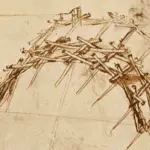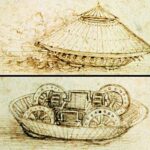Da Vinci Tank
Leonardo da Vinci is renowned as one of the most gifted polymaths in history. Known for his unsurpassed intellect and tireless curiosity, he made innumerable contributions across various fields, including art, science, music, invention, and more.
However, perhaps one of his most intriguing roles was that of a military engineer.
This facet of Leonardo’s genius gave us one of the most groundbreaking inventions in warfare technology: the Leonardo da Vinci tank, also often referred to as the da Vinci tank or Leonardo’s tank.
Leonardo da Vinci’s designs, such as the da Vinci tank and the giant crossbow, embodied innovative concepts that set the stage for the future of warfare technology.
His concept of a conical armored vehicle with cannons, developed in 1487, is a precursor to modern tanks.
Though never built, these sketches reveal da Vinci’s vision of military innovation and showcase his understanding of engineering and battle psychology.
For anyone fascinated by the evolution of war machines, da Vinci’s tank illustrates a pivotal moment in military design history. It represents an ambitious idea that sought to change the dynamics of warfare with its ability to move in any direction and fire from all sides.
These early ideas laid the groundwork for advances in armored vehicles.
His sketches include detailed plans to intimidate and scatter enemy forces. Leonardo da Vinci’s tank invention reflects the tactical strategies of the Renaissance.
Explore how his work influenced the history of tanks and challenged his contemporaries’ perceptions of warfare.
Leonardo da Vinci Tank: Historical Context
Leonardo da Vinci’s inventions pushed the boundaries of engineering during the Renaissance. Among his creations, the Leonardo da Vinci Tank stands out as an ambitious design that symbolizes the era’s advancements in military technology.
Leonardo da Vinci’s Innovations
Leonardo da Vinci’s engineering work showcased his extraordinary ability to envision futuristic machines. One such innovation was his design for the da Vinci Tank, often called the Leonards Tank.
It was conceived as a large armored car capable of moving in any direction. Its slanted armor offered some defense against enemy attacks. Inside, gears and cranks allowed operators to maneuver the vehicle.
The Leonardo da Vinci tank concept was never built during his lifetime. Despite this, its design highlights the blend of creativity and engineering that characterized Leonardo’s approach.
Men powered his tank manually, which would have been a significant limitation. Nonetheless, the concept paved the way for future innovations in armored vehicle designs.
Military Engineering in the Renaissance
During the Renaissance, military engineering dramatically changed with new tactics and machinery. Leonardo da Vinci played a key role in this transformation through his numerous military devices. His designs were part of a broader trend in which inventors began to explore more sophisticated war technology.
The Leonardo da Vinci armored car was a technological leap that revolutionized battlefield strategies. It mirrored the period’s intense experimentation with machines designed for both defense and attack.
While the da Vinci tank design was not realized, its ambitious intent demonstrates the forward-thinking spirit of the time. Leonardo’s work helped shape military strategies and pushed the boundaries of what was possible in warfare.
The Conception of Leonardo da Vinci Armored Car
The da Vinci Tank, also known as the da Vinci Armored Tank or Davinci Tank, was one of Leonardo da Vinci’s most revolutionary concepts.
This early iteration of a mobile fortress represents one of the earliest conceptions of what we today understand as a tank.
What was the da Vinci Tank called?
Leonardo’s innovative war machine was typically called the Leonardo da Vinci Tank or the da Vinci Armored Car.
Though we now recognize it as a precursor to the modern tank, it’s worth noting that Leonardo himself wouldn’t have used the term “tank” as it was not coined until World War I.
Origins and Initial Design Concepts
Leonardo da Vinci’s notebook, the Codex Atlanticus, contains the design of the armored tank, among many other drawings and ideas. It is a window into his vast intellect and unwavering curiosity.
The Leonardo da Vinci tank design was groundbreaking for its time. Conceived as a mobile fortress, it was intended to intimidate and scatter an opposing army.
The design proposed a circular platform on four wheels powered by manpower from within. The platform was to be covered by a large protective shell, designed with a sloping surface to deflect enemy fire better.
The Leonardos tank was designed to carry eight crew members. Its sides were adorned with an array of light cannons. The intention was to create a vehicle that could move in any direction and cause widespread damage without exposing the crew to direct harm.
Why did Leonardo da Vinci invent the tank?
Leonardo was a pacifist at heart but also a practical man living in turbulent times. To secure patronage, he offered his skills as a military engineer to the Duke of Milan, Ludovico Sforza, and later Cesare Borgia.
The creation of the Leonardo da Vinci tank invention was part of his efforts to impress his patrons with innovative war machines that could give them an edge in battle.
By inventing the Leonardo Davinci tank, he hoped to revolutionize warfare by offering a means of protection to soldiers while giving them the capability to counter-attack from within a mobile fortress.
He aimed to leverage the principles of mechanics to deliver a war machine that was both offensive and defensive—the concept that underpins the design of modern tanks.
The Design of Leonardo’s Fighting Vehicle
The da Vinci tank design was a remarkable blend of innovation, creativity, and a practical understanding of mechanics.
Let’s examine the Leonardo da Vinci tank blueprints, sketches, and models to learn more about the design’s intricacies.
Leonardo da Vinci Tank Blueprints and Sketches
The blueprints and sketches of the Leonardo da Vinci tank, found in the Codex Atlanticus, show a circular platform powered by two large inside cranks operated by the crew.
The cranks were attached to a system of gears connected to the wheels, allowing the tank to move in any direction.
The tank’s exterior was to be covered in a protective shell, like the shell of a tortoise, with light cannons protruding through the many holes on the sides.
This armored shell was designed to protect the crew while providing an all-round field of fire.
Leonardo da Vinci Tank Model
Based on his sketches, Leonardo da Vinci tank models show a bulky, circular fortress-like structure. The cranks and gears necessary for motion are housed inside, along with provisions for the crew to operate the cannons.
One interesting point about the tank’s design is that the gearing system, as drawn by Leonardo, wouldn’t work. The gears were set up so the wheels would cancel each other out, leaving the tank stationary.
Some historians believe Leonardo intentionally inserted this flaw because he was uncomfortable with the idea of his inventions being used for war. Others argue it was simply an oversight.
Did Leonardo da Vinci design the first tank?
While the term ‘tank’ wasn’t coined until centuries later, during World War I, Leonardo’s proposal for a covered, mobile, and armed fortress qualifies as a primitive tank design.
Therefore, it’s accurate to say that Leonardo da Vinci designed what could be considered the very first concept of a tank.
However, it’s important to note that Leonardo’s tank was never built during his lifetime and remained on paper as part of his vast collection of designs and ideas. Technology didn’t advance enough to make functional tanks until the 20th century, but Leonardo’s concept was a significant precursor to these modern machines.
The Functionality and Limitations of the da Vinci Armored Tank
The Leonardo Tank is a fascinating historical concept that intrigues scholars and enthusiasts today.
But how would it have fared in practice? Would it have truly revolutionized warfare, or were there inherent flaws in its design that would have rendered it ineffective?
Was the da Vinci Tank Ever Used in Battle?
No historical record suggests that the da Vinci Armored Tank was ever built or used in battle during Leonardo’s lifetime.
The technical capabilities of the 15th century were insufficient to create a working model of the tank.
The lack of powerful engines meant that the tank would have to be powered by the manpower of its crew, which would likely have rendered it slow and difficult to maneuver.
The Major Flaw in da Vinci’s Tank Design
- The gear mechanism is the most significant issue with the da Vinci Tank design. As Leonardo sketched it in the Codex Atlanticus, the gears would cancel each other out, leaving the tank immobile.
- This apparent flaw has led to a great deal of speculation. Some scholars argue that Leonardo, a known pacifist, may have deliberately included this flaw to prevent his design from being used for warfare. Others, however, believe it could have been an oversight. Despite his genius, Leonardo was human and thus prone to occasional errors.
- Another potential issue is the tank’s weight. The armored shell, cannons, and crew, all mounted on a moving platform, would have made it extremely heavy. With only human power for propulsion, it would have been challenging to move, particularly on rough terrains common in battlefields.
Despite these flaws, the Leonard tank concept demonstrates astonishing innovative thinking. The idea of a mobile, armored vehicle that could protect its occupants and carry firepower was centuries ahead of its time, and it paved the way for the development of modern tanks.
The Significance of the Leonardo da Vinci Tank Invention
Despite never being built, the Leonardo da Vinci tank is a testament to its credit creator’s genius and forward-thinking. It is particularly significant’s body of work and the broader field of warfare technology.
Da Vinci’s Innovations and Inventions
Leonardo da Vinci was not only an artist but also a scientist, engineer, and inventor. His work spans numerous disciplines, each with innovative ideas and insights.
His designs ranged from a printing press and parachute to a self-supporting bridge.
The tank or armored car adds to the diversity and depth of da Vinci’s work, proving his ability to think beyond the boundaries of the possible and conceive ideas far ahead of his time.
Leonardo da Vinci’s Contributions to Warfare Technology
Leonardo’s designs significantly reshaped warfare technology. His inventions showed a deep understanding of warfare’s mechanics and tactics, from the giant crossbow to the tank.
While the tank never saw a battlefield during Leonardo’s time, it was a forerunner to modern tanks, introducing the idea of a protected, mobile fortress armed with firepower.
This concept reshaped warfare tactics and strategies, leading to a new era of armored warfare.
The da Vinci tank is more than just an invention. It is a testament to the timeless genius of its creator, a landmark in the evolution of warfare technology, and a symbolic representation of the boundless capacity of human ingenuity.
In action
Below is a video showing how Leonardo da Vinci’s tank worked. At the end of the video, you will also see a model of this masterpiece by the great Leonardo da Vinci.
The Evolution of the Armored Tank
Though the Leonardo da Vinci tank was never built in its original form, it set the stage for the advent of the armored tank as we know it today.
Let’s briefly tour the tank’s history, from its conceptual origins with Leonardo to the muddy battlefields of World War I.
The Invention of the Tank and Its Inventor
While da Vinci was the first to conceive of a mobile, armored vehicle, the tank, as we recognize it today, was not developed until the 20th century.
The British are typically credited with inventing the tank during World War I. The British “Mark I” tank was the first to enter combat, deployed at the Battle of Flers-Courcelette on September 15, 1916.
But, a very important precursor to this modern tank was developed by the French mechanical engineer Léon Levavasseur, who patented a design for a vehicle with a “self-contained fuel source” in 1903.
The First Modern Tank
The Mark I tank was designed to overcome the problems of trench warfare, which had resulted in a deadly stalemate along the Western Front.
It was a far cry from the circular da Vinci tank, with a long, rhomboidal shape designed to cross trenches and a fully enclosed armored hull to protect its crew.
Equipped with powerful petrol engines, these tanks didn’t need the crew to manually move it like Leonardo’s tank would have.
Da Vinci Tank vs. World War I Tank Design
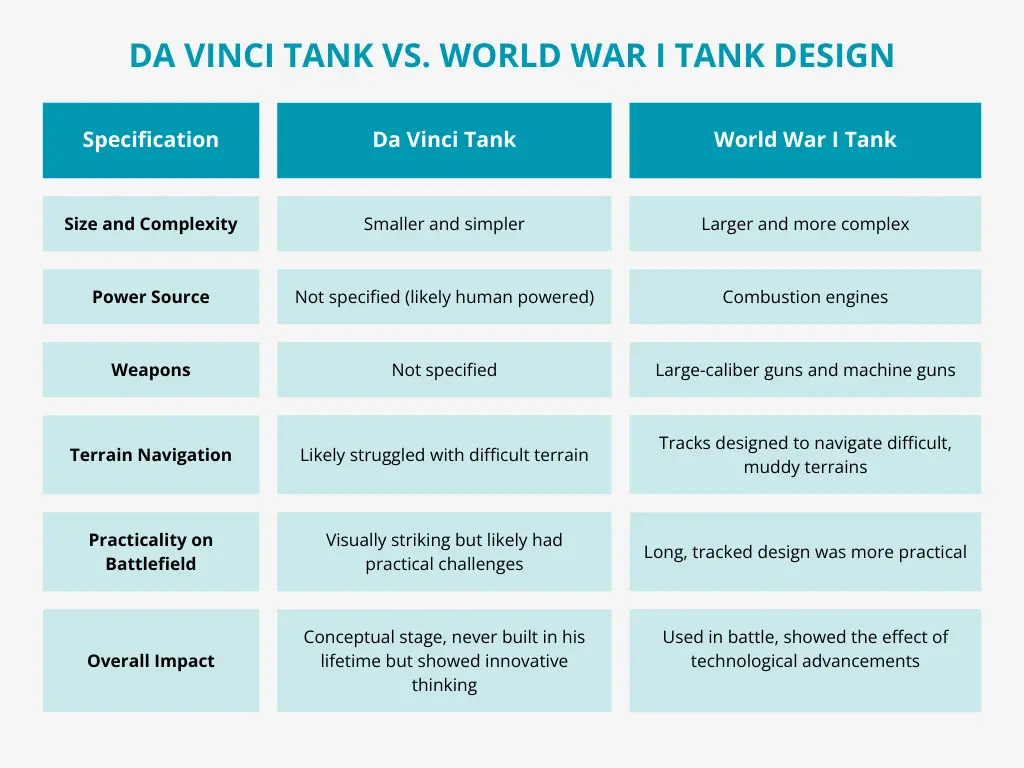
While da Vinci’s concepts never became a reality during his lifetime, his innovative thinking paved the way for later inventors to conceive and develop the armored vehicles that revolutionized warfare in the 20th century.
2005 Model of the Tank, one of Leonardo’s inventions, was in the Clos Luce mansion. Leonardo da Vinci lived there for the last three years and died.
Influence on Modern Warfare
The Leonardo da Vinci Tank significantly impacted the design and development of modern armored vehicles. His innovative concepts inspired the evolution of protective and mobile artillery used in warfare today.
Evolution of Armored Vehicles
Leonardo’s tank, with its unique conical shape and armored shell protecting the crew inside, was a revolutionary design that paved the way for modern tanks.
The Leonardo Da Vinci Tank provided the groundwork for vehicles capable of housing artillery, enabling military forces to move more safely on battlefields.
This concept was groundbreaking then and directly influenced the development of armored cars and tanks.
The Leonardo da Vinci armored car anticipated many aspects of modern military technology. While it never saw real-life construction, it sparked ideas for protective tank designs using heavy covering and self-propelled artillery platforms. Its inspiration contributed to enhancing military tactics focused on protection and mobility.
The idea of a vehicle that could attack and defend was a novel thought that armies continue to build upon.
Preservation and Legacy
Leonardo da Vinci’s tank is a remarkable example of his inventive genius, which influenced the design of future warfare machinery. His tank design is a source of inspiration, remains a popular subject in exhibitions and reproductions, and has had a significant cultural impact throughout history.
Exhibitions and Replicas
Exhibitions celebrating Leonardo da Vinci often showcase replicas of his tank. These replicas highlight the ingenuity of his design and offer insights into his futuristic vision.
Museums and institutions like the Museum of Science in Boston frequently feature detailed models. These exhibits show how da Vinci visualized armored warfare in the 15th century.
Some demonstrations include interactive models that help visitors understand the mechanics behind the tank. Successful reconstructions, like those documented in Da Vinci’s Machines, attempt to correct original design flaws, offering insights into potential functionality.
Cultural Impact
Leonardo da Vinci’s tank remains a symbol of innovation, often referenced in discussions of historical technological advancements. This Renaissance invention fascinates historians and technologists alike, demonstrating the leap from artistic sketches to mechanical engineering.
In modern culture, da Vinci’s tank appears in various media, including video games like Assassin’s Creed. These representations underscore its lasting influence and suggest reimagined possibilities.
The tank’s depiction in popular media emphasizes its iconic status in engineering and design history. Despite never being constructed in his time, the tank’s concept continues to resonate, embodying Leonardo da Vinci’s forward-thinking genius.
Final Thoughts
Leonardo da Vinci Tank represents a marvel of ingenuity, quite ahead of its time.
Designed in the late 15th century, the tank featured an armored shell and multiple cannons, showcasing Leonardo’s understanding of warfare dynamics.
Though it faced practical limitations due to its complex gearing system, its impact on the future of armored vehicles is undeniable.
Features of the tank included:
- A circular shape for enhanced defense.
- Slanted armor designed to deflect enemy projectiles.
- Ability to move in any direction.
Leonardo’s tank design was radical, influencing future military designs despite its non-implementation.
Leonardos tank had many heavy weapons, and its appearance was meant to intimidate enemies, adding psychological elements to its strategic purpose.
Recent efforts to rebuild the tank, such as those seen in documentaries, highlight its innovative aspects by correcting original design flaws.
These reconstructions have provided insight into the practicality of Leonardo’s vision.
Key Takeaways: Leonardo da Vinci Tank is a testament to his foresight and creativity in designing for warfare.
The tank’s influence can be seen in modern armored vehicles, reflecting Leonardo’s lasting legacy in engineering and design.
The exploration of his concepts continues to inspire advancements in military technology today.
Frequently Asked Questions
The Leonardo da Vinci Tank is a historically significant concept by the renowned artist and inventor. It played a notable role in the development of military technology during the Renaissance.
Did Leonardo da Vinci make a tank?
Leonardo da Vinci conceptualized a tank but did not construct a working model during his lifetime.
His Codex Atlanticus includes his design for an armored vehicle equipped with cannons intended for use on the battlefield.
How many cannons did the Da Vinci Tank have?
The Da Vinci Tank design included multiple cannons.
They were arranged in a circular pattern around the vehicle, allowing for firing in all directions. This innovative setup demonstrated Leonardo’s advanced thinking about warfare.
What was Leonardo da Vinci’s most significant invention?
Leonardo da Vinci’s most significant invention may be subjective, but several designs have had lasting influence.
His detailed sketches of flying machines and other inventions reveal his genius.
However, many consider his tank design one of his most remarkable military concepts.
What military things did Leonardo da Vinci invent?
Leonardo da Vinci’s military inventions included the tank, a giant crossbow, and a machine for storming walls.
He also designed several other innovative war machines. These designs showcased his deep interest in art and engineering and highlighted his diverse talents.
What is one flaw of Leonardo da Vinci’s tank?
One notable flaw in Leonardo’s tank design was its inability to move effectively over rough terrain.
Leonards tank’s weight and reliance on human-powered cranks limited its maneuverability, making it impractical for real-world battlefield use.
When was the first tank invented?
The first modern tank was invented during World War I.
It was developed by the British and first used in combat in 1916. Leonardo da Vinci’s concept predates this by several centuries, highlighting his forward-thinking visions.
Did da Vinci invent the car?
Leonardo da Vinci did not invent the car but designed a self-propelled cart.
This design is often cited as an early precursor to the automobile. The wooden vehicle was intended to move by winding up a series of springs.
Who did Leonardo da Vinci make weapons for?
Leonardo da Vinci designed weapons primarily for influential leaders of his time.
He worked for Ludovico Sforza, the Duke of Milan, and others. His designs showcased his skills in hopes of securing patronage.
What aircraft did Leonardo da Vinci invent?
Leonardo da Vinci sketched several concepts for flying machines.
Notable designs included a helicopter and a parachute. His ideas for flying machines were inspired by his observations of birds and flight dynamics.
Would Leonardo’s parachute work?
Leonardo da Vinci’s parachute design could theoretically work. Tests with modern materials have shown that it can effectively slow descent.
It demonstrates Leonardo’s understanding of the principles of aerodynamics.
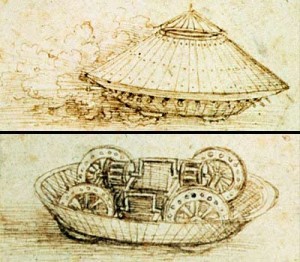
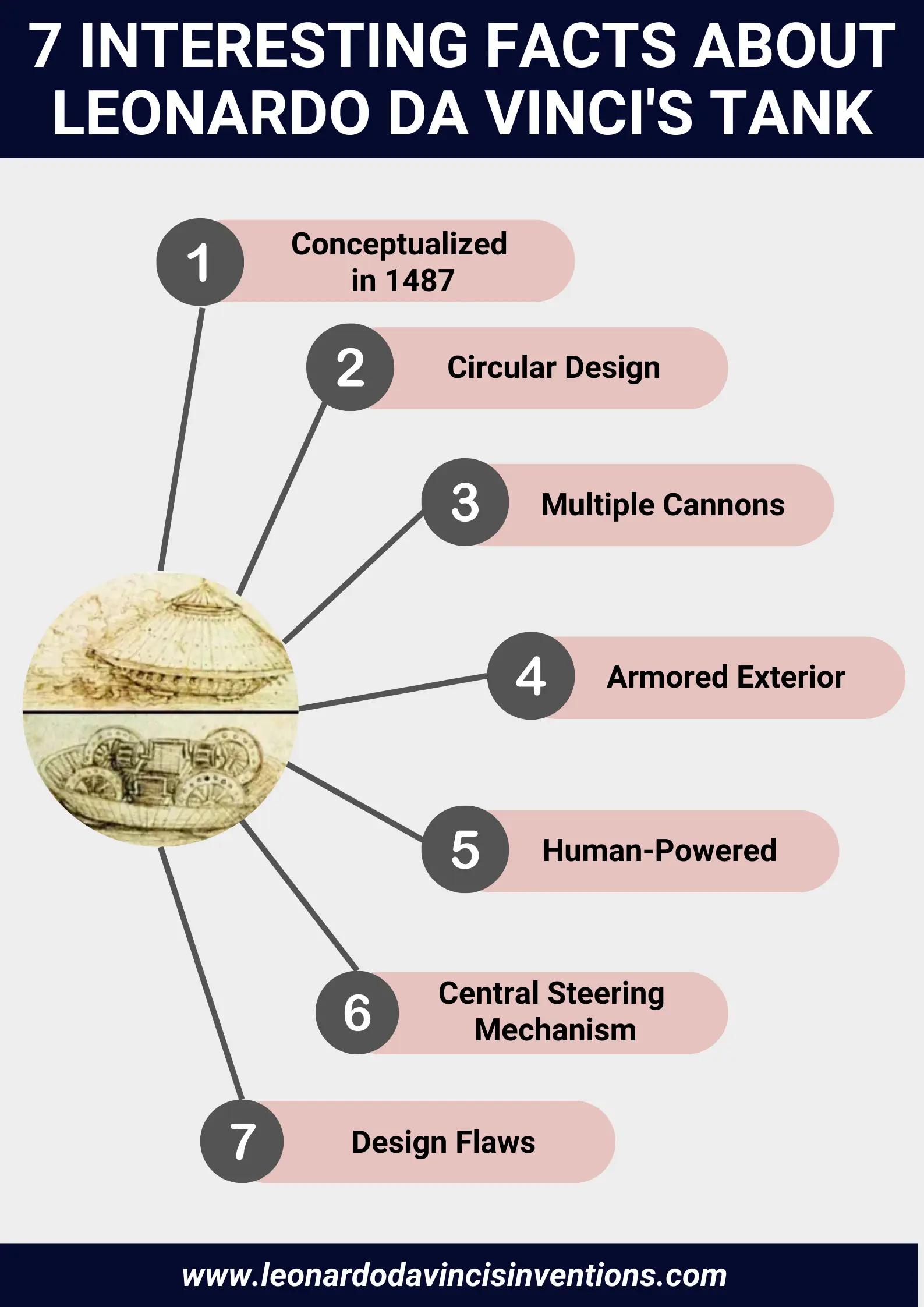
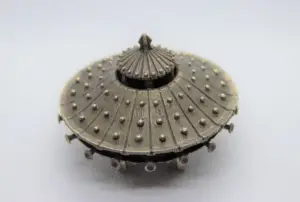
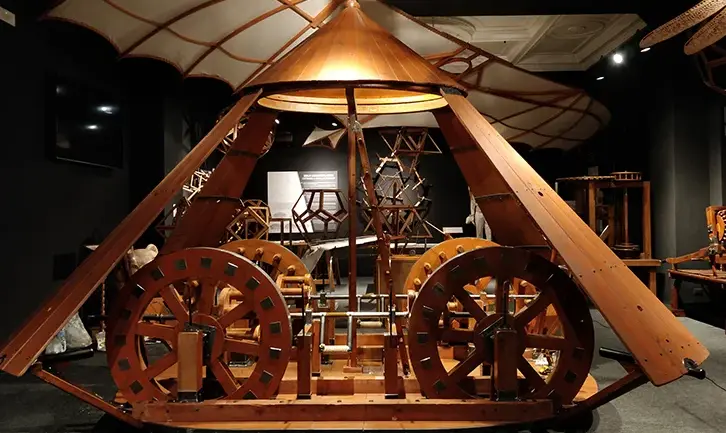
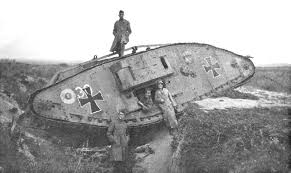

 I’m Leonardo Bianchi, the mind behind Leonardo da Vinci's Inventions. Thanks for visiting.
I’m Leonardo Bianchi, the mind behind Leonardo da Vinci's Inventions. Thanks for visiting. 